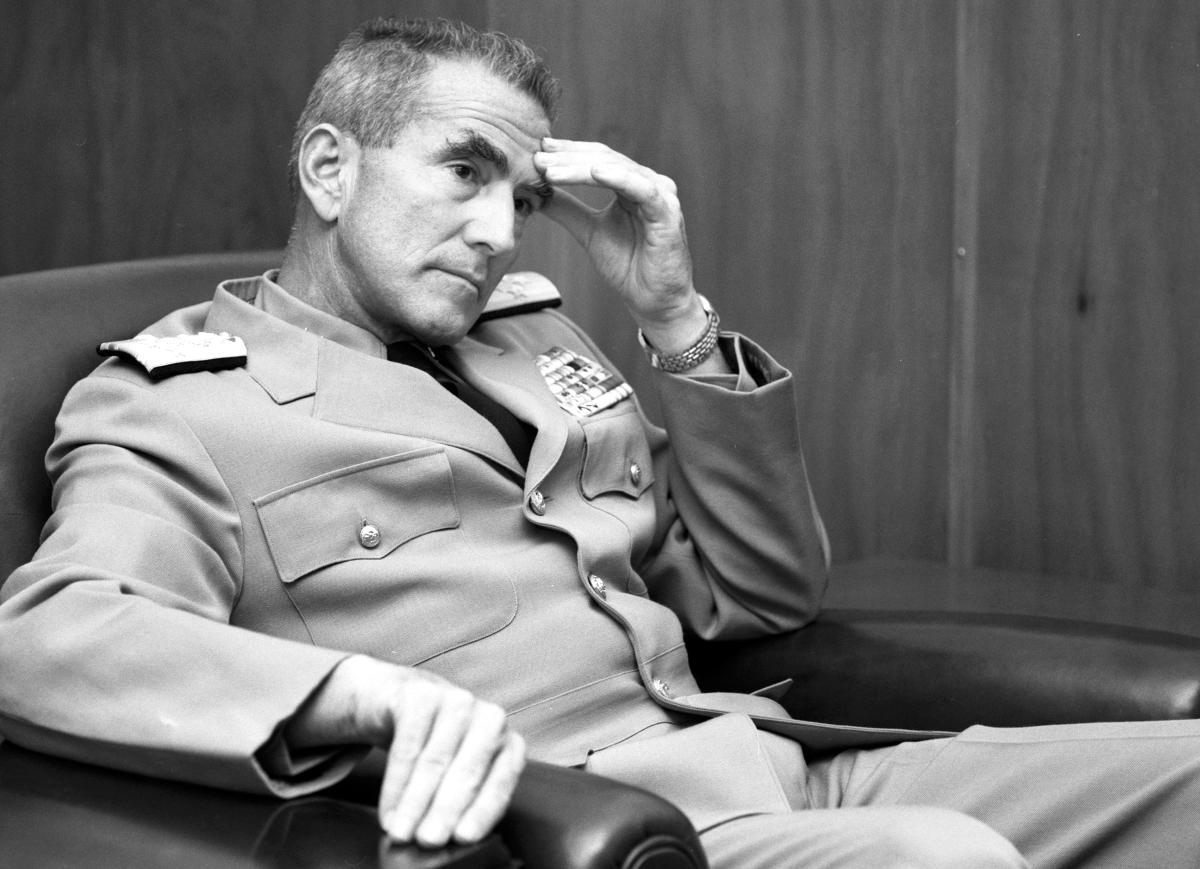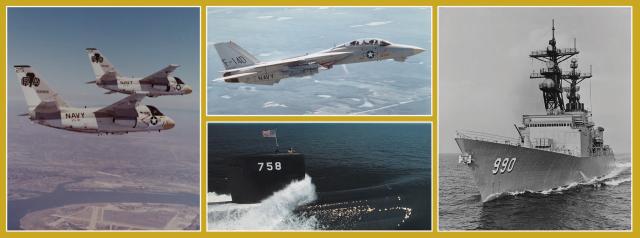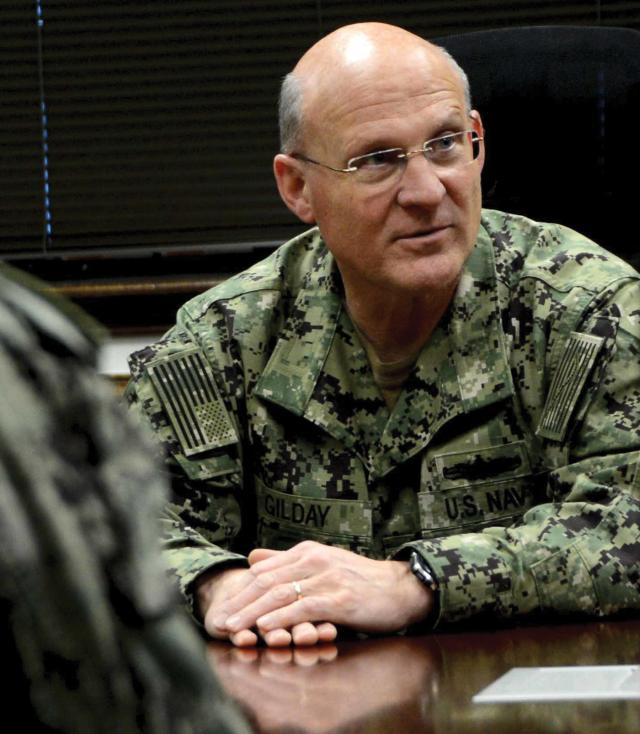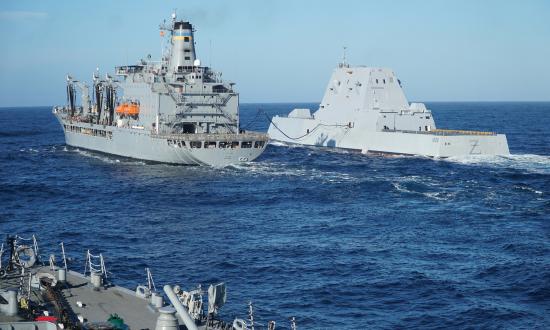The Chief of Naval Operations (CNO) sounded grim as he briefed the Secretary of Defense. He said the U.S. Navy faced an adversary with “a two-ocean Navy. If our Naval forces are reduced below the level of [the current fiscal year], we will no longer be able to oppose them simultaneously in the Atlantic and Pacific Oceans.”1 The year was 1970, the CNO was Admiral Elmo R. Zumwalt Jr., and the adversary was the Soviet Union.
Over the next four years, Zumwalt contested the Soviet threat and the lean budgets of the early 1970s with an eye toward the far future. He accelerated development of the next-generation strategic deterrent. He refocused the Navy on the mission of sea control, justifying numerous platforms and weapons that became operational in the 1980s. And he reformed personnel policies to improve retention and attract new recruits. By doing so, Zumwalt greatly contributed to U.S. maritime superiority at the end of the Cold War.
Fifty years later, the Navy faces a capable People’s Liberation Army Navy (PLAN), a resurgent Russian Federation Navy (RFN), and the menace of a lean defense budget in the aftermath of the coronavirus pandemic.2 Accordingly, Zumwalt’s example remains relevant to U.S. maritime superiority in an era of great power competition. But any discussion of Zumwalt must acknowledge that he fostered significant disciplinary issues and left unsatisfactory material readiness to his successor.
Project SIXTY
As CNO, Zumwalt faced substantial institutional inertia. Admiral William J. Crowe explained: “The CNO . . . can turn the helm, but the rudder doesn’t necessarily go with it, because there are a bunch of people down in the bowels pushing it the other way.” Zumwalt needed to concentrate his efforts if he was to achieve his “most earnest desire for one Navy, united in purpose, striving for common goals.”3
Zumwalt started by conducting a 60-day holistic review of the Navy, presenting his conclusions to Secretary of Defense Melvin Laird. Zumwalt’s review, known as Project SIXTY, served as his commander’s intent. He sent it to all Navy flag officers and Marine Corps general officers, saying, “[T]his presentation sets forth the direction in which we want the Navy to move in the next few years.”4 In it, Zumwalt laid out a number of priorities, which could be binned into three overarching lines of effort: maintaining the Navy’s strategic deterrent, refocusing the Navy on sea control, and implementing personnel policy reforms to improve retention.
Champion of the Trident Program
Project SIXTY began: “Strategic deterrence must come first.” This was because Zumwalt was concerned about Soviet advances in nuclear weapons and the 25-year life expectancy of the Polaris/Poseidon-armed nuclear-powered ballistic-missile submarines (SSBNs). The “41-for-Freedom” Polaris/Poseidon SSBNs had commissioned between 1959 and 1967, which meant they would start decommissioning in the early 1980s and be gone by the early 1990s. Knowing how long military procurement programs could take, Zumwalt believed the Defense Department needed to “accelerate” the next-generation SSBN program immediately.5
At Zumwalt’s direction, the CNO’s strategic planning office provided “the concept for Fleet Ballistic Missile Submarine (SSBN) involvement with hard-kill capability and laid the groundwork for the Trident II (D-5) program.” Armed with this study, Zumwalt and Defense Secretary Laird convinced Congress to commence funding the Trident missile and Ohio-class SSBN in 1972.6 A year later, after Laird left the Nixon administration, Congress sought to cut Trident funding. Zumwalt became one of the program’s champions on Capitol Hill, ultimately helping to sway enough senators to defeat the bill to cut Trident funding by two votes. Zumwalt referred to his efforts to convince Congress to fund Trident as the “most dramatic legislative struggle I took part in, and I am sure the most significant as well.”7
The ultimate timeline for the Ohio class justified Zumwalt’s high prioritization: The 18 Ohios entered service from 1982 through 1997, providing sufficient margin for the older SSBNs to decommission without risking a gap in deterrent coverage.8
Restoring the Importance of Sea Control
The Navy also faced a threat it had not seen since the Battle of Leyte Gulf: an enemy battle fleet capable of contesting command of the sea—in the air, on the surface, and beneath the waves. Zumwalt said:
We . . . face conventional war that will not include the sanctuary of full use of our sea lines of communication. The Soviets have conceded us this luxury in the past, in part because of our nuclear superiority, in part because of their belief that we could defeat them at sea in conventional war. But now the Soviet Navy has evolved impressively in both size and spectrum of capabilities.9
Zumwalt’s fleet was not ready to fight such a high-end war. Because the Navy had not faced a credible enemy fleet in 25 years, it had focused on antisubmarine warfare (ASW), power projection, and strategic deterrence. To make matters worse, much of the 750-ship Navy dated back to World War II and was reaching retirement. To blunt the Soviet threat, Zumwalt decided the Navy needed to refocus on sea control at the expense of missions such as power projection and peacetime presence.10
To swiftly change course, Zumwalt concluded, “We must invest heavily in the future, even if we must pay for it by reducing current force levels.” In the short term, he augmented diminished aircraft carrier air wings with Marine Corps aircraft squadrons and sped up installation of the Vulcan Phalanx Close-In Weapon System to defend surface ships against modern Soviet missiles.11
In the long term, he emphasized high-end platforms. Even though Zumwalt later advocated the concept of the “High-Low Navy,” he did not discuss it in Project SIXTY—the word “low” appears only six times in the document and not in reference to platforms. Instead, Zumwalt said: “I am impressed with the need for sophistication in the sea control mission, to counter the high quality submarines being produced by the Soviets. We need sophisticated carrier task forces for defense against Soviet anti-ship missiles launched from either submarines, aircraft, or surface ships.” As a result, Zumwalt continued development of the Los Angeles–class fast-attack nuclear-powered submarine, the S-3A Viking ASW aircraft, the F-14 Tomcat interceptor, the Spruance-class destroyer, and others. In addition, he enhanced surface ship ASW capabilities by basing helicopters on board destroyers and frigates. He also accelerated production of the Harpoon antiship missile.12
Finally, Zumwalt’s strategic course change spurred a renaissance of naval strategy. Thanks to Zumwalt, naval historian John Hattendorf concluded, by “the mid-1970s, sea control seemed to dominate discussions.”13 These sea control discussions found their ultimate expression in the Maritime Strategy of 1986.
‘Improving the Quality of Navy Life in All Respects’
But there was an even greater challenge. Fourteen days after relieving as CNO, Zumwalt messaged the Navy: “No other problem concerns me as deeply as reversing the downward trend of Navy retention rates and I am committing myself to improving the quality of Navy life in all respects and restoring the fun and zest of going to sea.” To do this, Zumwalt commenced a series of retention study groups. From these, and his own experiences, Zumwalt concluded that the Navy needed “to instill at all levels an attitude which clearly recognizes the dignity and worth of each individual and creates an environment in which every officer and enlisted man will be treated with respect and accorded the trust, confidence, and recognition each human being wants and deserves.”14
the Cold War era. U.S. Naval Institute Photo Archive
To implement his reforms, Zumwalt communicated directly to the entire Navy through messages known as “Z-Grams.” Zumwalt wanted his Z-Grams to have the widest possible dissemination, even upbraiding subordinates in a “Personal For” message for failing to ensure all hands saw them. He recalled later: “I do not think that my program would have had much of a chance if I had not made that first, all-out effort to tell the world about it. For basically it was not I, but the sailors in the fleet, and their families, and the media, and even some members of Congress who overcame the inertia, or in some cases the opposition, of the system and forced the reforms through.” Zumwalt’s successor as CNO, Admiral James L. Holloway III, agreed: “I am convinced Admiral Zumwalt’s personal style was essential to the attainment of the Navy’s objectives. Shock tactics were required to defeat the resistance to change inherent in the institutionalized Navy.”15
Among Zumwalt’s targets were old-fashioned restrictions on junior sailors. When Zumwalt became CNO, the only enlisted sailors allowed to have civilian clothes on board ship were chief petty officers. Zumwalt expanded this privilege to all sailors. Similarly, sailors’ overnight liberty, even in home port, required special request chits. Zumwalt eliminated this requirement, mandating: “Overnight liberty will . . . be treated . . . as the normal form of liberty for our responsible sailors.”16 In addition, Zumwalt allowed sailors to wear working uniforms to and from work, in commissaries and exchanges, and in the mess.
Zumwalt pursued other initiatives to improve retention. He used the Civil Engineering Corps to renovate housing and recreational facilities. He directed that “reenlistments should be meaningful occasions marked by appropriate ceremonies.” He set maximum enlisted sea tour lengths. He directed Navy personnel support centers to set customer-oriented operating hours and service: “I do not consider personnel services as ‘frills’ or even as nonmission related. On the contrary, if they support our men and their dependents, I consider them vital to our readiness.”
Many of Zumwalt’s other personnel innovations remain, including:
- The Navy sponsor program
- The Meritorious Advancement Program, promoting high-performing sailors who have not been able to pass their rating’s examination
- The Navy ombudsman program
- The Navy Sailor of the Year program
- The fleet, force, and command master/senior chief petty officer programs.
Zumwalt believed his personnel reforms succeeded. When he became CNO, the Navy’s reenlistment rate was an unsustainable 9.5 percent; when he left, it was 32.9 percent.17 How much of this was because of his reforms and how much was because of the troubled economy of the 1970s is debatable. Future Secretary of the Navy John Lehman, however, pointed to a long-term positive impact: “Many of the naval leaders of the past 30 years, including me, decided to stay with the institution because of the new spirit Zumwalt sparked.”18
‘Back to Battery After Zumwalt’
In the short term, however, Zumwalt’s many reforms spawned significant disciplinary issues. Captain Howard Kerr, who commanded a destroyer at the time, recalled that junior sailors “attached . . . the most liberal interpretation possible” to Z-Grams.19 Some sailors took advantage of new privileges without demonstrating the increased responsibility expected of them. They believed that Zumwalt’s “elimination of demeaning and abrasive regulations” meant they no longer needed to respect their leaders. A number of senior enlisted sailors, believing their authority had been undercut by the CNO, chose to retire, causing a retention shortfall among chief petty officers.20 Vice Admiral Raymond Peet summarized: “[Zumwalt’s] personnel policies were well-meaning but also . . . misinterpreted, and the sailors felt he was encouraging them to bypass their petty officers and the chain of command. He was, in effect, lowering the standards.”21
Zumwalt admonished these disruptive sailors through his Z-Grams, concluding: “Prejudice against good order and discipline is as bad as the prejudice of race . . . the Navy is no different than any other institution in that it requires complete and total obedience.”
Despite Zumwalt’s efforts, however, severe disciplinary issues remained. Zumwalt’s successor, Admiral Holloway, said, “The problems that the Navy was having, we directly placed it to the personnel policies of Zumwalt because the chain of command disappeared.” Holloway’s second Vice CNO, Admiral Harold Shear, remarked that “probably the most important thing I did in 42 years of active duty was to get the Navy pulled together and back to battery after Zumwalt.”22
The troubles were not just disciplinary. Shortly after relieving as CNO, Admiral Holloway discovered “the material condition of the fleet was deplorable . . . [based] on the steadily increasing number of material casualty reports per month, the growing percentage of ships not fully ready for war, for deployment, or even for getting underway.”23 Although many naval leaders and Congress contributed to the fleet’s decline, as the previous CNO, Zumwalt was immediately responsible.
Zumwalt’s neglect of material readiness owed much to his background, which “had not included much exposure to engineering or technical matters.”24 Zumwalt’s antipathy toward technical matters was underscored by his all-too-brief mention of material readiness in his 1972 priorities update to the fleet. In the message, Zumwalt took 105 words to discuss “Pride and Professionalism,” but he devoted only 15 to “high standards of material readiness.”
Lessons from Admiral Zumwalt
To some degree, subsequent CNOs have followed Zumwalt’s lead. Former CNO Admiral John M. Richardson, and the current CNO, Admiral Michael M. Gilday, developed their own Project SIXTYs—Admiral Richardson’s Design for Maintaining Maritime Superiority and Admiral Gilday’s Fragmentary Order (FRAGO) to the Design.
Admiral Gilday’s FRAGO prescribes lines of effort to improve warfighting and warfighters and build up the future Navy. But it was written before the coronavirus economic bailouts. Unfortunately, the Navy now faces a similar situation to that described by Zumwalt 50 years ago: “[Our] force options are constrained by an imminent decline in the Defense budget.”25 As the Navy faces tough choices, it would do well to look at Admiral Zumwalt’s priorities and learn from his missteps.
As Zumwalt said in 1970: “Strategic deterrence must come first.” The first Ohio replacement SSBN, the Columbia (SSBN-826), is not slated to go on patrol until October 2030, but the schedule is already in doubt. Former CNO Richardson told Congress in April 2019: “We are on schedule, but just on schedule. We are on cost, but just on cost.”26 Consequently, the Navy needs to redirect additional funds and manpower to ensure the Columbias go to sea in time—and not grant a deterrence gap to competitors.
Turn force structure toward sea control. Just like 1970, the Navy faces a credible sea control threat. Focused on defeating the United States at sea, PLAN surface ships, submarines, and aircraft (including helicopters) almost all carry advanced supersonic, long-range antiship missiles. Although the United States has made great strides with turning the SM-6 Standard Missile into an antiship weapon, as well as developing the long-range antisurface missile (LRASM), the Navy is still years away from having a substantial inventory of antiship missiles.27
To rush new sea control weapons and platforms to the fleet in the near future, the Navy needs to judiciously cut current platforms and weapons that do not contribute to sea control. As Admiral Zumwalt said in Project SIXTY, “Prospective budget levels and the implications of the current and growing . . . threat at sea require us to turn our force structure toward the sea control mission and to reduce accordingly the forces that support other missions.”
Pursue personnel policy reforms that make the Navy a profession, not a job. The Navy should follow Zumwalt’s reforming example to make much-needed modifications to career paths, joint professional education, and retirement criteria. The Navy also must better address working spouses, improve retention of female sailors who must juggle careers and family, and match modern expectations of parenthood and education. If the Navy does so, it can inspire sailors to meet Admiral Zumwalt’s goal to “consider our service not as a job which requires only regular hours and limited commitment, but as a profession which demands of us our very best efforts, freely and willingly given, on behalf of our country.”28
Tie priorities to an honest assessment of competitors. Zumwalt filled Project SIXTY with detailed tables and charts showing the remarkable improvements in Soviet capabilities, as well as projected U.S. losses against the Soviet Navy. When Zumwalt advocated for Trident, sea control, and personnel reform, he based his advocacy on his thorough knowledge of the Soviet threat.
Zumwalt credited his success in the pivotal Trident vote of September 1973 to this knowledge. To persuade some undecided senators, Zumwalt accepted an invitation by Senator Bennett Johnston to debate nuclear arms control activist Herbert Scoville in Johnston’s office. During the debate, Zumwalt pointed out that Scoville recently had claimed the Soviets would not attempt to deploy nuclear-tipped multiple independently targeted reentry vehicles, which they had done the very next month. Zumwalt recalled that this “pretty much destroyed Scoville’s credibility as either a strategic or a political expert. . . . The session with Scoville . . . got the Navy two or three hitherto doubtful votes on Trident.”29
The Navy should emulate Zumwalt’s knowledge of the Soviets by more openly focusing attention on the PLAN and the RFN. Just as Admiral Zumwalt convinced the Secretary of Defense, skeptical congressmen, and his fellow sailors to execute his priorities by knowledgably describing the Soviet threat, the Navy would be wise to detail the growing threat of the PLAN and RFN, to educate not only the Navy’s personnel, but also all Americans.
Do not make Zumwalt’s mistakes. As the Navy makes changes, it should benefit from Zumwalt’s example. New privileges need to be tied to increased personal responsibility. Leaders must reinforce the chain of command’s authority at all levels. Finally, the Navy must continue to prioritize material readiness.
‘Regaining the Undisputed Supremacy at Sea’
Eight years after Zumwalt’s retirement, the Navy possessed a renewed strategic deterrent and a fleet capable of fighting for sea control. In addition, many of Zumwalt’s personnel reforms had been codified, and his successors had resolved most disciplinary and material problems.
As the Department of Defense faces a post-coronavirus budget crunch, the Navy should refocus on Zumwalt’s priorities of strategic deterrence, sea control, and personnel reform. Naval leaders should openly discuss the threat the Chinese and Russian navies pose to the United States and the free seas. Finally, naval reformers must heed the warnings of Zumwalt’s example with regard to discipline and material readiness.
After half a century, there is still much to learn from the 19th Chief of Naval Operations. By doing so, the Navy will “set us steaming on a heading toward regaining the undisputed supremacy at sea which our national survival demands.”30
1. ADM Elmo R. Zumwalt Jr., USN, “Project SIXTY,” 10 September 1970, in U.S. Naval Strategy in the 1970s: Selected Documents, Newport Paper no. 30, John B. Hattendorf, ed. (Newport, RI: Naval War College Press, 2007), 27.
2. Robert Burns, “Bulging Deficits May Threaten Prized Pentagon Arms Projects,” Associated Press, 12 May 2020.
3. ADM William J. Crowe Jr., USN (Ret.), with David Chanoff, The Line of Fire: From Washington to the Gulf, the Politics and Battles of the New Military (New York: Simon & Schuster, 1993), 86–87; Z-Gram 87, “Navy Uniform,” 131037Z June 1971, List of Z-Grams, Naval History and Heritage Command, (hereafter cited as NHHC Z-Grams).
4. John B. Hattendorf, Introduction to U.S. Naval Strategy in the 1970s, Hattendorf, ed., 1–2; ADM Elmo R. Zumwalt Jr., USN (Ret.), On Watch: A Memoir (New York: Quadrangle, 1976), 66–67; Zumwalt, “Project SIXTY,” 3.
5. Zumwalt, On Watch, 153.
6. John B. Hattendorf, The Evolution of the U.S. Navy’s Maritime Strategy, 1977–1986, Newport Paper no. 19 (Newport, RI: Naval War College Press, 2004), 8–9; James John Tritten, “The Trident System: Submarines, Missiles, and Strategic Doctrine,” Naval War College Review 36, no. 1 (January–February 1983): 62.
7. Francis Duncan, Rickover and the Nuclear Navy: The Discipline of Technology (Annapolis, MD: Naval Institute Press, 1990), 47–48; Zumwalt, On Watch, 152.
8. Norman Friedman, U.S. Submarines since 1945, Revised Edition: An Illustrated Design History (Annapolis, MD: Naval Institute Press, 2018), 204–7, 250–52, 255.
9. Zumwalt, “Project SIXTY,” 5.
10. Hattendorf, The Evolution of the U.S. Navy’s Maritime Strategy, 193; Hattendorf, Introduction to U.S. Naval Strategy in the 1970s, ix; Zumwalt, “Project SIXTY,” 5–10.
11. Zumwalt, “Project SIXTY,” 16–20, 21.
12. Zumwalt, 17–20.
13. Hattendorf, The Evolution of the U.S. Navy’s Maritime Strategy, 193.
14. Z-Gram 2, “Retention Study Groups,” 141350Z July 1970, NHHC Z-Grams; Z-Gram 93, “People Programs,” 061627Z July 1971, NHHC Z-Grams.
15. Z-Gram 52, “Personal for All Flag Officers, Commanders, Commanding Officers, Officers-in-Charge: Dissemination of CNO Policy,” 232239Z October 1970, NHHC Z-Grams; Zumwalt, On Watch, 178; ADM James L. Holloway III, “Memorandum to the Secretary of the Navy, Subject: Goals for the next CNO, December 1973,” 6210709005, Admiral Elmo R. Zumwalt, Jr. Collection: General Correspondence, Vietnam Center and Sam Johnson Vietnam Archive, Texas Tech University.
16. Z-Gram 57, “Demeaning or Abrasive Regulations, Elimination of,” 102157Z November 1970, NHHC Z-Grams.
17. Zumwalt, On Watch, 271.
18. John Lehman, “Zumwalt: The Life and Times of Admiral Elmo Russell ‘Bud’ Zumwalt, Jr. by Larry Berman,” The Washington Post, 8 December 2012.
19. CAPT Howard J. Kerr Jr., USN (Ret.), “Z-Grams and the Mod Squad,” U.S. Naval Institute Proceedings 110, no. 12 (December 1984): 98.
20. Norman Friedman, “Elmo Russell Zumwalt, Jr.,” in The Chiefs of Naval Operations, Robert William Love Jr., ed. (Annapolis, MD: Naval Institute Press, 1980), 377–78.
21. The Reminiscences of Vice Admiral Raymond E. Peet, U.S. Navy (Retired), oral history conducted by CDR Etta-Belle Kitchen, USN (Ret.) (Annapolis, MD: U.S. Naval Institute, 1984), 173.
22. ADM James L. Holloway III, USN, interviewed by MIDN Seth K. Powell, USN, 25 October 2004, transcript available appended to MIDN Seth K. Powell, USN, “‘Train for the Known, Educate for the Unknown:’ The Navy’s Struggle for Clarity with Graduate Education in the Humanities, from Holloway to Rickover,” history honors thesis, U.S. Naval Academy, 2005; The Reminiscences of Admiral Harold E. Shear, U.S. Navy (Retired), oral history conducted by Paul Stillwell (Annapolis, MD: U.S. Naval Institute, 1997), 312.
23. ADM James L. Holloway III, USN (Ret.), Aircraft Carriers at War: A Personal Retrospective of Korea, Vietnam, and the Soviet Confrontation (Annapolis: Naval Institute Press, 2007), 348.
24. Holloway, Aircraft Carriers at War, 343.
25. Zumwalt, “Project SIXTY,” 15.
26. Megan Eckstein, “Navy: USS Columbia Will Have Most Complete Design Ever at Official Construction Start,” USNI News, 9 May 2019. ADM John M. Richardson, USN, quoted in Sam LaGrone, “SECNAV, CNO Update Congress on Columbia SSBNs, New Large Surface Combatant,” USNI News, 1 May 2019.
27. The PLA Navy: New Capabilities and Missions for the 21st Century (Suitland, MD: Office of Naval Intelligence, 2015), 16–17, 19–22; Ronald O’Rourke, China Naval Modernization: Implications for U.S. Navy Capabilities, CRS Report no. RL33153, (Washington, DC: Congressional Research Service, 2019), 5, 23; David B. Larter, “As China Expands Navy, U.S. Begins Stockpiling Ship-killing Missiles,” Defense News, 11 February 2020.
28. Ben Werner, “GAO: Women 28 Percent More Likely to Leave Military Service than Men,” USNI News, 20 May 2020; Z-Gram 93, “People Programs,” 061627Z July 1971, NHHC Z-Grams.
29. Zumwalt, On Watch, 161.
30. Z-Gram 121, “CNO Change of Command Remarks by Admiral E. R. Zumwalt, USN,” 291600Z June 1974, NHHC Z-Grams.











